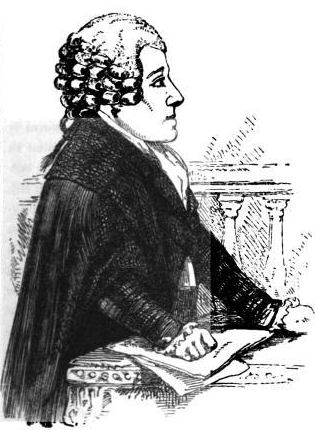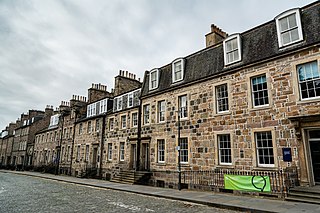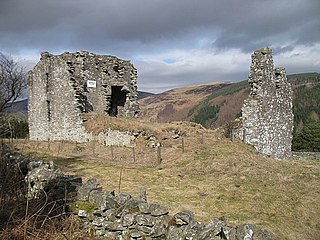
The Dundas Riots were a series of riots in Edinburgh over three consecutive days in June 1792. They are sometimes also called the King's Birthday Riots. [1]

The Dundas Riots were a series of riots in Edinburgh over three consecutive days in June 1792. They are sometimes also called the King's Birthday Riots. [1]



The riots came on the back of a period of civil unrest, variously sourced from feelings transferring from the French Revolution, further changes in the Corn Laws, food shortages, and a general unhappiness of the population with their leading figures in politics and law. [2] A proclamation banning "seditious writing" had been passed in May 1792. [3]
It was traditional at that time for officials and soldiers to celebrate the birthday of King George III: 4 June. [4]
On the days preceding the riots, the Lord Provost of Edinburgh, Sir James Stirling of Larbert, had cavalry soldiers roaming the Edinburgh streets to intimidate the population. This had the reverse effect, and angered the general population. [5]
On the evening of 4 June members of the City Guard and Cavalry were getting drunk at Old Parliament Hall near St Giles Cathedral. They fired pistols in the air with each toast. A mob appeared outside and were dispersed after some stone-throwing. No-one was injured.
On the following evening (5 June) a small mob (not necessarily the same group) gathered outside the house of Robert Dundas of Arniston, Lord Justice Clerk at the time. This was at 57 George Square in the north-east corner. They had a straw effigy of a man. Dundas's neighbours, Admiral Duncan of Camperdown and Sir Patrick Murray of Ochtertyre, tried to dispel the crowd but stone-throwing began and they all sheltered in Dundas's house. The crowd began to break the windows and a servant was sent via the back door to run to Edinburgh Castle for assistance. [6]
The servant persuaded the commander of the castle to send around a dozen troops from the 53rd Cavalry Regiment, armed with sabres and pistols, to the Dundas house. Given the day, it is highly likely that the troops were intoxicated. Arriving at George Square probably around 40 to 60 minutes after being sent for, the crowd was still there. The Riot Act was read. This was a legal requirement before physical force was used, but the action in its own right is clearly inflammatory, as it implies an intention to attack. Immediately upon completion of the reading the troops burst through the crowd. The majority appear to have fled diagonally across the square, seeking the open ground of the Meadows. The wisdom of this against mounted troops is clearly dubious. Several bodies were found on the edge of the Meadows on the following morning. [6]
That evening (6 June) a new mob assembled outside the house of Sir James Stirling, 1st Baronet (the then Lord Provost of Edinburgh) on the south-east corner of St Andrew Square in the New Town. A City Guard sentry box near the house was set upon and smashed to pieces. Edinburgh Castle, learning of the disturbance, lit a beacon fire on the half moon battery, and that signalled a beacon to be lit on Calton Hill. The pre-arranged signal allowed HMS Hind, moored in Leith Docks, to dispatch a company of marines into the city. Combining forces with cavalry troops from the castle, the mob dispersed. Provost Stirling had by then sought refuge in Edinburgh Castle. The local doctor Alexander Wood, was mistaken by the angry mob for Stirling and narrowly avoided being thrown off North Bridge due to the misunderstanding. [6]
The Edinburgh goldsmiths decried the actions of the mob in a public statement on 7 June. There followed a series of public declarations of loyalty of various trade halls, swearing loyalty to the constitution. At a meeting held from 11 to 13 December 1792, 170 representatives met at a hall in James Court off the Royal Mile, representing various Societies of Friends from across Scotland (aka the first Friends of the People Convention). Most notable of those present was Thomas Muir of Huntershill, a Glaswegian by birth, but then an Edinburgh lawyer. Divisions in public opinion began to appear, but the majority supported the old status quo. Muir was prosecuted the following year for his part in the convention and for being the Edinburgh publisher of Thomas Paine's then controversial book "The Rights of Man". [3]
Although Thomas Muir of Huntershill is not named as one of the rioters in June, it is logical to presume he was either present or had encouraged the actions. Certainly Robert Dundas of Arniston is said to have remained in Edinburgh to watch those involved "like a hawk" and report to London his findings. Muir was the focus of all his attention, and given Dundas's position, Muir was then doomed. When Muir became trapped in Paris due to the outbreak of war he could not attend court as required, and was automatically outlawed by Dundas... ultimately being sent to Australia in punishment. [7]
57 George Square bears a plaque, but to Benjamin Rush rather than Robert Dundas or the Dundas Riots. Rush was a student at the University of Edinburgh (which erected the plaque) but there is no known link between the building and Rush, whereas the true history of the building is ignored.

The Porteous Riots surrounded the activities of Captain John Porteous, Captain of the City Guard of Edinburgh, Scotland, who was lynched by a mob for his part in the killing of innocent civilians while ordering the men under his command to quell a disturbance during a public hanging in the Grassmarket, Edinburgh in April 1736. Although the rioters were generally supportive of the convicted smugglers, Porteous seems to have been a somewhat overbearing official, despised by the mob and the underclasses of Edinburgh society.
Captain John Porteous was a Scottish military officer who served in the Edinburgh City Guard and played a major role in the Porteous Riots, which resulted in his death.

Thomas Muir, also known as Thomas Muir the Younger of Huntershill, was a Scottish political reformer and lawyer. Muir graduated from Edinburgh University and was admitted to the Faculty of Advocates in 1787, aged 22. Muir was a leader of the Society of the Friends of the People. He is included in the Political Martyrs' Monument in Edinburgh.

The Battle of Falkirk Muir, or Battle of Falkirk, took place near Falkirk, Scotland, on 17 January 1746 during the Jacobite rising of 1745. A narrow Jacobite victory, it had little impact on the campaign.
Robert Dundas of Arniston, the elder, 2nd Lord Arniston (1685–1753) was a Scottish lawyer, and Tory politician who sat in the House of Commons from 1722 to 1737. In 1728 he reintroduced into Scottish juries the possible verdicts of guilty or not guilty as against proven or not proven. He was Lord President of the Court of Session from 1748 to 1753.

Robert Dundas of Arniston, the younger, FRSE was a Scottish judge. He served as Solicitor General for Scotland from 1742 to 1746, as Lord Advocate from 1754 to 1760, and as Member of Parliament for Midlothian from 1754 to 1761. He was Lord President of the Court of Session from 1760 to 1787, losing his popularity for giving his casting vote against Archibald Douglas in the famous Douglas Cause.

Robert Dundas of Arniston was a Scottish judge.

Clan Dundas is a Scottish clan.

Arniston House is a historic house in Midlothian, Scotland, near the village of Temple. This Georgian mansion was designed by William Adam in 1726 for Robert Dundas, of Arniston, the elder, the Lord President of the Court of Session. The western third of the house was added by John Adam, son of William and brother of Robert Adam, in 1753.

Greyfriars Kirkyard is the graveyard surrounding Greyfriars Kirk in Edinburgh, Scotland. It is located at the southern edge of the Old Town, adjacent to George Heriot's School. Burials have been taking place since the late 16th century, and a number of notable Edinburgh residents are interred at Greyfriars. The Kirkyard is operated by City of Edinburgh Council in liaison with a charitable trust, which is linked to but separate from the church. The Kirkyard and its monuments are protected as a category A listed building.

George Square is a city square in Edinburgh, Scotland. It is in the south of the city centre, adjacent to the Meadows. It was laid out in 1766 outside the overcrowded Old Town, and was a popular residential area for Edinburgh's better-off citizens. In the 1960s, much of the square was redeveloped by the University of Edinburgh, although the Cockburn Association and the Georgian Group of Edinburgh protested. Most but not all buildings on the square now belong to the university. Principal buildings include the Gordon Aikman Lecture Theatre, Edinburgh University Library, 40 George Square and Appleton Tower.
Events from the year 1799 in Scotland.

Sir James Stirling, 1st Baronet of Larbert and Mansfield was a Scottish banker who served three consecutive terms as Lord Provost of Edinburgh.
Sir William Honyman, 1st Baronet, also known by his judicial title Lord Armadale, was a Scottish landowner, and judge from Orkney. On his lands in Sutherland he was one of the first landlords to evict tenants in order to create sheep farms, a process which grew to become the Highland Clearances.
Events from the year 1796 in Scotland.
Events from the year 1792 in Scotland.

Events from the year 1793 in Scotland.
Events from the year 1765 in Scotland.

George Douglas of Parkhead,, was a Scottish landowner, mining entrepreneur, Provost of Edinburgh, and Keeper of Edinburgh Castle.

Sir Gideon Murray of Elibank, was a Scottish courtier and landowner.